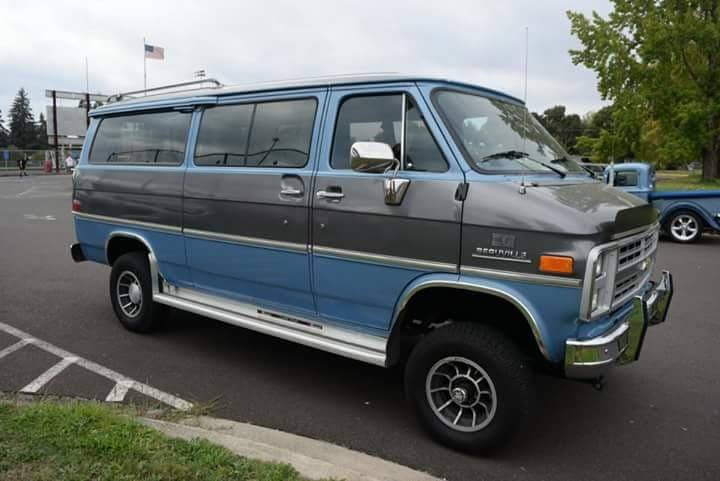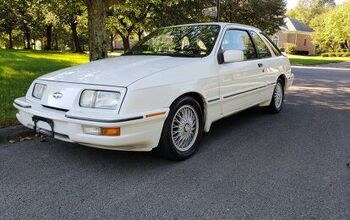Rare Rides: This Chevrolet Beauville Is a Quigley 4×4 From 1989

In The Current Year, new car lots are filled with family-friendly adventure vehicles. They’ve got lots of seats, lots of cladding, and some sort of system to drive all four wheels (even if it’s a lousy system like on the CR-V). But our Rare Ride comes from a time when family 4×4 options were much fewer in number. 1989 was a very different time for the adventuresome family buyer.
Enter Quigley, and the Chevrolet Beauville.
First we’ll talk Quigley. The company started out as a car dealership in Massachusetts, Bill Quigley Auto Sales, in 1966. The dealership added campers and trailers to its lot and started customizing vans in the early Seventies. Motor homes were next on the menu. The dealer’s relationship with GM grew stronger, and the genesis for extra-capable vans came in 1974 when Quigley first added a 4×4 system to a Chevrolet Van.
Quigley is still around today, customizing and adding four-wheel drive systems to GM, Ford, and Nissan vans. Their most recent product addition is a 4×4 Ford Transit. Now, on to Beauville.
Chevrolet first used the Beauville name in 1954, adding it to the wagon variant of the popular Bel Air family sedan. The trend didn’t last long; the last Beauville 210 wagon rolled off the assembly line in 1957. The name didn’t resurface until 1971, when it served as a trim level for Chevrolet’s “Van.”
Of course, the Van Chevrolet sold in 1971 was nearly the same one the company sold in 1995. For a full 24 years, the third-generation Chevrolet Van rolled out of factories in Lordstown, Ohio, Flint, Michigan, and Scarborough, Ontario (which is a part of Downtown Canada).
The third-generation Van marked a departure for Chevrolet, as the first and second generations of 1964 and ’67, respectively, were of the mid-engine and forward control variety. Those were called Handi-Van and Handi-Bus by GMC, and Sportvan by Chevrolet. The more modern front-engine, rear-drive layout was based on the long-lived C/K truck platform. Trims had names like Bonaventure, Nomad, Bonanza, and of course Beauville.
Engines ranged from a thrifty-ish 4.1-liter inline-six through a thirsty 7.4-liter gasoline V8, with a couple of diesels in between. Transmissions were of three- or four-speed manual or automatic variety.
The buyer of today’s Rare Ride went with a luxurious Beauville trim for the basis of their van. With a Chevrolet 350 and four-speed automatic to shift all the tweed and curtains, extra capability was added via the Quigley 4×4 conversion — at a cost of $10,000. Original deep-dish wheels compliment the tidy blue and gray two-tone theme. With 78,000 miles on the clock, this go-anywhere family van asks $14,500.
[Images: seller]

Interested in lots of cars and their various historical contexts. Started writing articles for TTAC in late 2016, when my first posts were QOTDs. From there I started a few new series like Rare Rides, Buy/Drive/Burn, Abandoned History, and most recently Rare Rides Icons. Operating from a home base in Cincinnati, Ohio, a relative auto journalist dead zone. Many of my articles are prompted by something I'll see on social media that sparks my interest and causes me to research. Finding articles and information from the early days of the internet and beyond that covers the little details lost to time: trim packages, color and wheel choices, interior fabrics. Beyond those, I'm fascinated by automotive industry experiments, both failures and successes. Lately I've taken an interest in AI, and generating "what if" type images for car models long dead. Reincarnating a modern Toyota Paseo, Lincoln Mark IX, or Isuzu Trooper through a text prompt is fun. Fun to post them on Twitter too, and watch people overreact. To that end, the social media I use most is Twitter, @CoreyLewis86. I also contribute pieces for Forbes Wheels and Forbes Home.
More by Corey Lewis
Latest Car Reviews
Read moreLatest Product Reviews
Read moreRecent Comments
- Probert They already have hybrids, but these won't ever be them as they are built on the modular E-GMP skateboard.
- Justin You guys still looking for that sportbak? I just saw one on the Facebook marketplace in Arizona
- 28-Cars-Later I cannot remember what happens now, but there are whiteblocks in this period which develop a "tick" like sound which indicates they are toast (maybe head gasket?). Ten or so years ago I looked at an '03 or '04 S60 (I forget why) and I brought my Volvo indy along to tell me if it was worth my time - it ticked and that's when I learned this. This XC90 is probably worth about $300 as it sits, not kidding, and it will cost you conservatively $2500 for an engine swap (all the ones I see on car-part.com have north of 130K miles starting at $1,100 and that's not including freight to a shop, shop labor, other internals to do such as timing belt while engine out etc).
- 28-Cars-Later Ford reported it lost $132,000 for each of its 10,000 electric vehicles sold in the first quarter of 2024, according to CNN. The sales were down 20 percent from the first quarter of 2023 and would “drag down earnings for the company overall.”The losses include “hundreds of millions being spent on research and development of the next generation of EVs for Ford. Those investments are years away from paying off.” [if they ever are recouped] Ford is the only major carmaker breaking out EV numbers by themselves. But other marques likely suffer similar losses. https://www.zerohedge.com/political/fords-120000-loss-vehicle-shows-california-ev-goals-are-impossible Given these facts, how did Tesla ever produce anything in volume let alone profit?
- AZFelix Let's forego all of this dilly-dallying with autonomous cars and cut right to the chase and the only real solution.






































Comments
Join the conversation
"Complement", not "compliment" (unless the wheels can speak). Great find on the van!
Don't think the author has any clue how the awd system in the current generation CRV works. Can send up to 70% of the power to the rear axel and allocate 100% the power to the left of right wheel. Very similar to the previous SH AWD system from Acura. I spent a summer cleaning brush for Hydro up in northern Ontario and spent time driving a GMC Vandura 4wd conversion van. It barely fit down the grown in bush roads, we put so many scratches on the exterior from tree branches and stumps. The winch cable snapped when we tried to winch out of a hole.